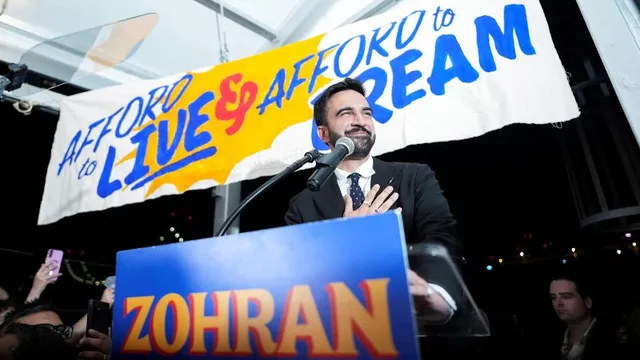
Zohran Mamdani wins crucial Democratic Primary in New York
2025-06-25 00:00- Zohran Mamdani won the New York Democratic Mayoral Primary, signaling a shift toward leftist policies.
- The political climate has seen increased support for rent freezing policies amongst major candidates.
- The election outcomes highlight the entrenchment of socialist ideas in New York's mainstream political discourse.
Express your sentiment!
Insights
In New York, the political landscape is shifting as Zohran Mamdani's recent victory in the Democratic Mayoral Primary marks a significant moment for the city's left-wing movement. Mamdani, a self-proclaimed socialist, emphasizes a progressive agenda that includes freezing rents on approximately one million rent-stabilized housing units. His rise in popularity is partly attributed to his dynamic social media presence. This leftist viewpoint, however, is not as radical as it may seem in the context of New York politics, where even centrist candidates are endorsing similar housing policies. Historically, rent stabilization has long been a contentious issue in New York. During the tenure of former Mayor Bill de Blasio, calls for rent freezes became a routine discussion. Eric Adams, the current mayor and Mamdani's opponent in the upcoming general election, supported de Blasio’s freeze on rent increases back in April 2020, showcasing that even the mainstream political candidate espouses policies staunchly aligned with socialist ideologies. The Rent Guidelines Board subsequently voted to cap rent increases for one-year rent-stabilized leases, reflecting a broader trend of interventionist policies in New York's housing market. The eviction moratoriums implemented around the same time further complicated the landscape for landlords. They essentially allowed tenants to postpone rent payments without legal repercussions, thereby significantly impacting property owners and their revenue. With the pandemic affecting rental agreements, both landlords and tenants face a precarious situation. The state's 2019 rent law, enacted under former Governor Andrew Cuomo, heavily restricted property owners from raising rents and removing units from rent control, leading to increasing financial strain among landlords. Opposition to these laws has persisted, with property owners challenging them in court, deeming them unconstitutional. While New York's housing policies remain a point of contention, what is striking is the uniformity amongst candidates regarding rent stabilization—a situation that few could have anticipated. Furthermore, as the Rent Guidelines Board revisits potential rent increases, the debates and discussions surrounding Mamdani’s victory indicate that the conversation about housing affordability and rent control will only intensify, continuing to shape the future of New York's residential landscape. The implications of these political dynamics could redefine the relationship between landlords, tenants, and the city government, underlining the urgency for comprehensive housing reform.
Contexts
Rent control in New York City has a complex and multifaceted historical context, stemming from the economic pressures and social dynamics that have shaped the city over the decades. Initially introduced during World War II in 1943, rent control was aimed at addressing the acute housing shortages that arose due to the influx of workers and military personnel. These controls were originally conceived as temporary measures, meant to stabilize rents and prevent landlords from exploiting the situation by enforcing unreasonable rent increases. However, over time, what started as a short-term solution evolved into a permanent fixture in the housing landscape of New York. The program expanded beyond its wartime necessity into a broader framework that included rent stabilization laws thereafter enacted in the 1960s and 1970s, drawing a clear distinction between the two forms of rent regulation based on the nature of the residential units and their age in relation to the regulatory framework. The sustained implementation of rent control has elicited both strong support and fierce opposition, revealing deep divisions among stakeholders. Advocates argue that rent control protects vulnerable tenants from displacement in a city where housing costs have skyrocketed, perpetuating a sense of community and stability. They also contend that these laws are crucial in preventing homelessness and that they provide a safety net for low to moderate-income residents amidst rising rents. Critics, on the other hand, posit that rent control creates distortions in the housing market, discouraging new developments and renovations as landlords may be disincentivized to invest in properties if they cannot freely adjust rents to market rates. This tension leads to a multifaceted debate about the future of housing policy in New York City, with various stakeholders pushing for reforms to balance tenant protections with the need for a thriving rental market. The political landscape surrounding rent control has also evolved. Initially, progress towards rent regulation was driven by a coalition of labor groups, housing advocates, and political figures who recognized the need for tenant protection. Over time, property owners and real estate interests began to organize more effectively, campaigning for deregulation and arguing for the necessity of a free market to stimulate housing production. Various legislative measures have been debated in the New York State legislature, including the repeal or modification of rent control and stabilization regulations, which highlight the ongoing struggle over housing policy and regulation in a city known for its economic disparities. In 2019, significant legislative changes were made, marking a pivotal moment as lawmakers reformed rent laws to strengthen tenant protections, reflecting the shifting political and social landscapes regarding housing in New York. The historical context of rent control in New York City is essential in understanding the ongoing discourse on housing policy, wealth inequality, and urban development. As the city grapples with demographic shifts, market pressures, and a growing population, the future of rent control and its potential adaptations will remain a critical area of focus. Policymakers, advocates, and stakeholders must consider not just the immediate implications of any reforms, but also the long-term impact on the housing market, community stability, and overall urban development. This underscores the necessity for nuanced discussions and data-driven policy decisions that balance the interests of tenants with the economic realities faced by property owners.